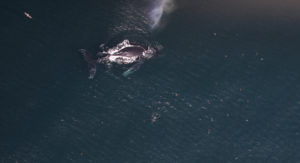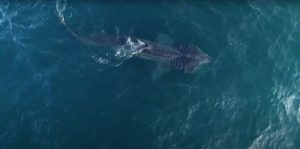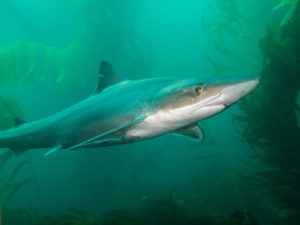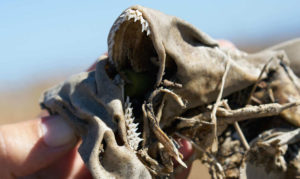It is Shark Week on the Discovery Channel, which means it’s time for lots of toothy grins and fighter-jet-size sharks leaping from the sea and distressed seal pups fleeing in frothy panic. Also, if you are Save the Bay restoration scientist Hayley Zemel, it is a great time to talk about tidal wetlands.
Pickleweed-mosaic margins at the edge of the Bay, when we’re celebrating, you know, sharks? Definitely. Because not all (or even many) of the 500 species of sharks are the leapy-toothy-fighter-jet-size variety, including the resident sharks of the San Francisco Bay, and our six local regulars rely on healthy wetlands. Tidal marshes are food factories for the small fish and invertebrates Bay sharks favor, and even better, our warm, shallow estuary is a major shark nursery.
Take the spiny dogfish. The third-most common Bay resident, it grows to about three feet or so and meanders around the Bay in groups, with occasional, seasonal trips to colder offshore waters. The spiny dogfish has the longest gestation period of any shark species, Zemel says: it doesn’t begin to reproduce until it’s at least 12 years old (some estimates say 20), and even once it starts, only a few of its half-dozen pups will survive to reach maturity themselves. Resource-rich wetlands improve the chances that the long cycle succeeds.
Or take the charismatic sevengill, the apex predator in the Bay (minus the occasional white shark poking its nose past the Golden Gate; they don’t usually stick around long). The sevengill used to be found everywhere around California, but now sticks mainly to San Francisco Bay and Humboldt Bay, where there are still healthy wetlands available as a nursery. It doesn’t just need the wetlands for its own reproduction, though: it eats the fish that themselves use the wetlands for eating and babymaking. Halibut, for example, which have been steadily increasing in central California since 1995, about the year, Zemel says, major wetland restoration work started.
“It’s hard to make bold statements like, ‘This is because of wetland restoration,’” she says. “But halibut are known to rely on these wetland areas for nursery grounds, and 1995, that’s kind of when wetland restoration was starting to become more of a thing. That’s important to say.”
There is evidence that the salt pond restoration on former Cargill land has benefitted the leopard shark, the most common Bay resident. Researchers have found their numbers increasing dramatically in the restored ponds; UC Davis marine scientist James Hobbs has reported catching as many as 30 sharks in an hour at one pond at Eden Landing Ecological Reserve in Hayward.
Hobbs’s recent research on restored-pond leopard sharks aside, there’s not much data on the Bay’s other sharks. The population probably reaches into the hundreds of thousands, but there’s no hard evidence. We have almost nothing to go on for individual species population sizes, and little information about where in the Bay sharks go and when. We can guess that pollution is a major threat — leopard sharks in the salt ponds show high levels of mercury and we know that there’s water pollution in many areas of the Bay — but we don’t really know how great the threat is.
“What we do know is that sharks are an integral part of the overall ecology of the Bay and ocean, as well as a prime indicator of the richness of this estuary,” wrote former East Bay Regional Park District chief naturalist Ron Russo in the April 2001 issue of Bay Nature. “Right below the lanes of traffic on the San Mateo Bridge, there exists a complex and dynamic underwater world ruled by organisms that evolved over 300 million years ago.”
While leopard and sevengill sharks are common aquarium residents, it’s hard to peer into their world in the wild: the South Bay isn’t snorkeling territory. (Although you can snorkel or scuba dive for leopard sharks up and down the California coast.) But you can help them anyway on a wetland volunteer trip. And next time you’re out there in the Bay mud struggling to root out a particularly tough invasive weed or dig some native seedling into the ground, you can say to yourself: it’s for the sharks.
For more Bay Nature shark coverage, check out our articles on the salt pond restoration and leopard sharks in April 2014, the curious seven gills of the sevengill shark in July 2011, and the sharks of the San Francisco Bay in April 2001.
Want to restore a wetland for a shark (or anything else)? Save the Bay leads regular volunteer restoration trips to marshes around the Bay. A calendar of volunteer opportunities can be found at: http://www.savesfbay.org/volunteer/calendar

.jpg)



